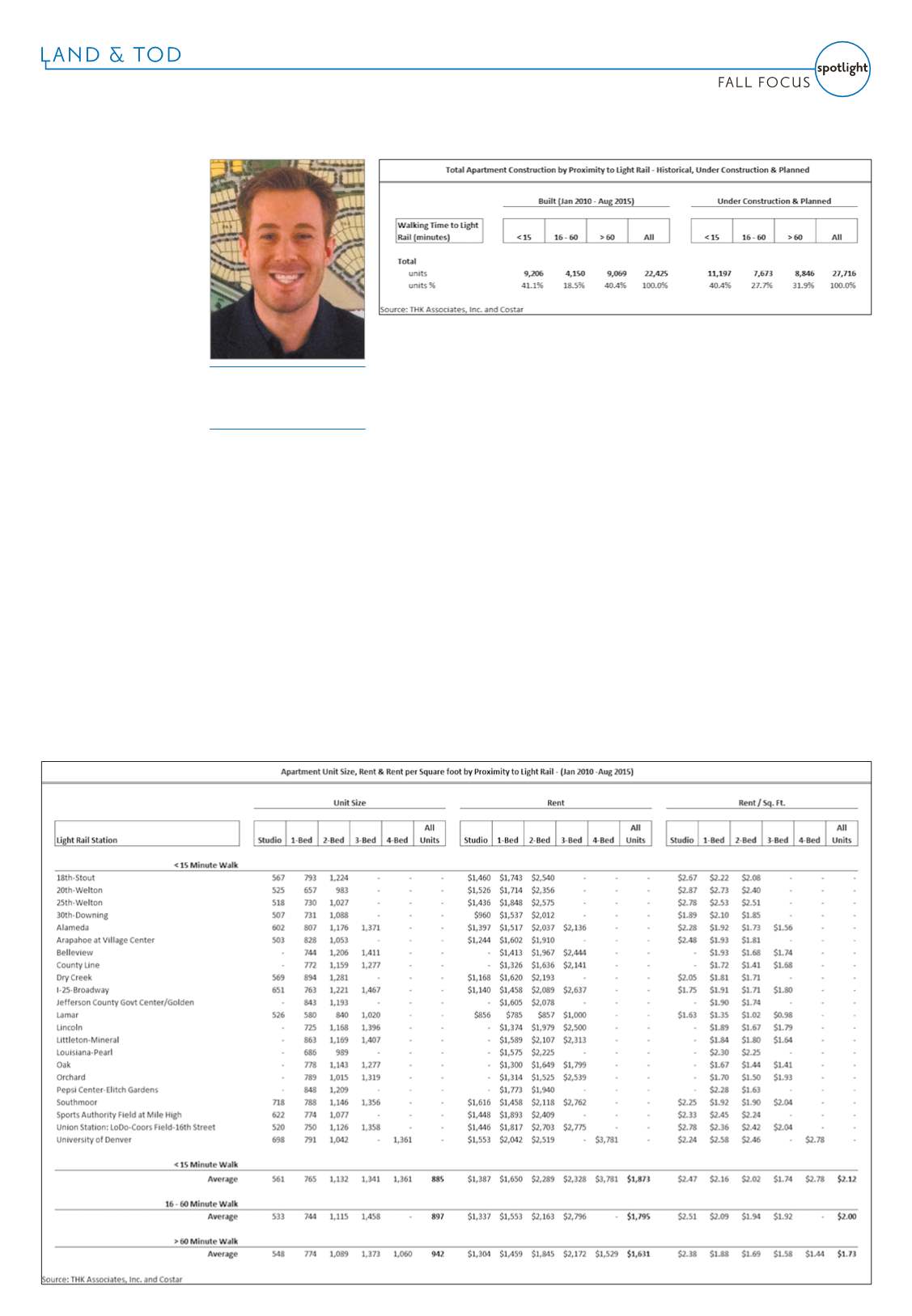
Page 12B—
COLORADO REAL ESTATE JOURNAL
—
September 2-September 15, 2015
T
he Denver light-rail
system consists of
48 miles of track
connecting 46 stations.
With construction currently
underway on five different
light-rail lines, an additional
98 miles of track and 34 new
stations are expected by 2018.
As a result of this rapid transit
growth, pun-intended, transit-
oriented rental apartment
developments are abounding
and attracting an urban-
centered demographic focused
on finding a sense of place
that minimizes transportation
costs and congestion hurdles.
The mixed-use developments
along TOD stations are further
connecting Coloradoans’
doorsteps directly to the
airport, sporting venues,
downtown attractions and
suburban locations like Aurora
and Wheat Ridge.
The level to which demand
is driving development and
investment to previously
overlooked areas, including
Broadway Station and the
Regatta Plaza at Nine Mile
Station, is now evident. We
compiled an inventory of
rental apartment buildings
with more than 20 units
from CoStar’s database for
the seven-county area of
Adams, Arapahoe, Boulder,
Broomfield, Denver, Douglas
and Jefferson counties.
The data in the charts details
how apartment characteristics
change with proximity to
light rail and how those
characteristics differ among
individual light-rail stations.
Furthermore, a proximity
comparison of apartment
supply and characteristics by
unit type between January 2010
and August 2015 and for units
currently under construction
and planned also is shown.
In Chart 1, apartment unit
characteristics are segmented
into three timeframes – a
15-minute walk, a 16- to
60-minute walk and a
60-plus-minute walk from
the nearest light-rail station.
The aggregated CoStar data
assumes that it takes about 15
minutes to walk one-half mile.
While light-rail stations tend
to be built along populated
areas that naturally command
higher rents, regression
analysis that isolates the true
impact on rental rates of light
rail from higher-priced real
estate locations is beyond the
scope of this article. Instead,
this article focuses on poking
holes in or confirming ideas
about economic impacts
on apartment rents, square
footage, supply, unit mix and
overall development trends
along the lines throughout
Denver.
Chart 2 details apartment
unit size, rent and rent per
square foot by proximity to
light-rail stations. There were
22,425 apartment units built
over the last five years, and
there are currently 27,716
apartment units under
construction and planned
within the seven-county area.
Of the units built over the last
five years, 41.1 percent are
located within a 15-minute
walk of a light-rail station,
while 40.4 percent of units
under construction or planned
will be located within the same
proximity. By comparison, 18.5
percent of units built over the
last five years are located within
a 16- to 60-minute walk time
of a light-rail station, while
27.7 percent of units under
construction or planned will
be located within the same
proximity. Finally, 40.4 percent
of units built over the last
five years are farther than a
60-minute walk from a light-
rail station, while 31.9 percent
of units under construction
or planned are located at the
same proximity.
These statistics give rise to
the notion that, although
numerous sources and
professionals are purporting
a large volume of apartment
developments occurring near
light-rail stations, the exact
distances at which these
apartment developments are
occurring need clarification.
The number of apartment
units under construction and
planned within a 15-minute
walk of a light-rail station as a
percentage of total apartment
construction is projected to
decrease slightly over the
next several years. In contrast,
the number of apartment
units under construction
and planned within a 16- to
60-minute walk of a light-rail
station as a percentage of
total apartment construction
is projected to increase by
49.7 percent, and the number
of apartment units under
construction and planned
beyond a 60-minute walk of
a station as a percentage of
total apartment construction is
projected to decrease by 21.1
percent over the next several
years, according to THK
Associates.
The data totals shown for
each walking time are weighted
averages, and the 15-minute
walk time category is further
detailed according to light-
rail station. For all unit types
located within a 15-minute
walk of a light-rail station,
the average unit size is 885 sf,
the average monthly rental
rate is $1,873 and the average
monthly rental rate per sf is
$2.12. For all unit types located
within a 16- to 60-minute
walk from the nearest light-
rail station, the average unit
size increases slightly to 897
sf, while the average monthly
rental rate decreases to $1,795,
or $2 per sf. Apartment units
Steven Saules
Financial and market analyst,
THK Associates, Denver
Chart 1: Total apartment units and percentage based on proximity to light-rail stations
Chart 2: The volume of all apartment units by walking time in minutes to the nearest light-rail station


